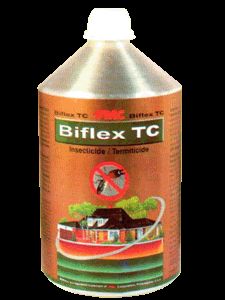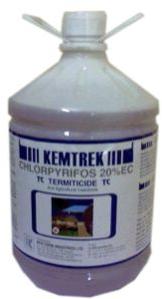
LENTREK TC
Subterranean termites, the most common kind, live in soil. There are distinct castes within each colony – the largest group being the workers.. Blind and wingless, the workers bore galleries in wood, forage for food and care for other members of the colony. It is the workers, along with newly-hatched nymphs that do the damage to the structure. Soldier termites protect the colony from attack by invaders such as ants, in its final growth stage; the soldier termite acquires a long armoured head and large strong jows. Each colony has one queen, or more, whose mission is to lay eggs. These develop into new colony members. There is only one primary queen, when she dies, secondary queen are often produced. Once a year, new members of the winged reproductive caste develop. A single colony may produce several hundreds of these. When environment conditions are ideal, these new reproductive’s leave the colony in a swarm to seek mates and start new colonies. After flying a short distance the swarmers fall to the ground, break off their wings, locate mates and then seek a small space beneath a rock or wood in direct contact with the soil to begin a new colony. EVIDENCE OF TERMITE INFESTATION SWARMS that occur within a building are positive evidence that the structure is infested. Swarmers are attracted to light and are often seen in large numbers around windows. GALLERIES IN WOOD. Wood damaged by termites has galleries that tend to run with the grain, although some will cross the grain, these galleries can be distinguished from similar damage caused by other wood-infesting insects because they usually contain soil particles instead of sawdust. MUD TUBES are also evidence of an infection. When termites cross concrete and similar materials to reach wood, they construct these tubes as a shelter. The tubes are made of soil particles cemented together with saliva and excreted fluid waste. SOIL PASSAGES. Termites feed on wood and cellulose materials, but they also need constant moisture to survive. Colonies usually nest in the soil which provides that moisture. MOIST WOOD and wood which is direct contact with the soil such as under a dirt filled porch, provide ideal condition for termites.
...more
Biflex TC
Biflex TC is a synthetic pyrethroid modeled on mother nature’s very effective insecticide pyrethrum which is extracted from the Pyrethrum Daisy. Bifenthrin, the active ingredient in Biflex TC is used in several countries to control a variety of pests like termites, ants, cockroaches, mosquitoes, spiders, chinch bugs, fleas, wasps and more. It is also used extensively to protect wood against wood damaging insects like termites and borers. Biflex Tc is the most advanced development in today’s growing world of termiticides. Based on a unique pyrethroid called bifenthrin, Biflex TC brings unequalled levels of termiticidal activity Furthermore, Biflex TC also provides significant improvements to the health and safety of both the Pest Control Applicators and the Homeowners. Biflex TC protect with responsibility. These important benefits of Biflex TC are due to the unique characteristics of the bifenthrin molecule and represent the most singnificant breakthrough in termite control since the introduction of the organochlorines some 50 year ago. Biflex has been thoroughly tested in areas of severe termite pressure globally and is the most widely used termiticide in its class- used around the world in several countries including the United State of America, Australia, and Japan. The product has also been extensively tested and recommended in India by the Central Building Research Institute ( CBRI ), Roorkee, for pre-Construction and Post- Construction anti-termite treatment. Double Action Protection Biflex Tc solves your termite problems in two ways. Not only does it work Quickly to KILL ACTIVE TERMITES, it also creates an invisible protective barrier that surrounds your home to REPEL TERMITES. Some termiticides only kill termites when they penetrate a chemically treated zone as they move towards a structure. With Biflex TC termiticide, the active ingredient prevent termites from crossing the barrier AND kills them on contact. The advantages of a repellent barrier vs.non-repellent zone are obvious. Even when a Biflex TC termiticide barrier becomes thin or weakened over time, it will still provide protection since it reduces the pressure of the attack through repellency and hence termites do not challenge the barrier. However, termites will challenge and may penetrate a thin or weak non-repellent treated zone. The wooden block on Biflex TC (0.05% ) treated soil remained totally protected from termite attack while the block on untreated soil was severely damaged at the same site. This long-term Modified Ground Board test was independently conducted by CBRI, Roorkee at multiple locations in India. Longest Protection Period The expected period of protection provided by a soil applied termiticide should be one of the key factors when deciding on a suitable product. Biflex last longer in several worldwide field tests. USA In the United States Department of Agriculture (USDA) Gulfport test sites of Arizona ,Florida,Mississippi, and South Carolina, Biflex termiticide has the longest residual protection period in the industry: Average of more than 13 year of 100% control at all USDA sites AUSTRALIA Australia is one of the few countries that require the manufactures to mention the protection period provided by their chemicals on the label. Biflex has the longest registered protection period * when compared with any competitive product. The USDA tests determine the year’s of-effectiveness of currently marketed and protentially new termiticides treatments to soil under long-term field conditions. Results are provided to the EPA as part of the registration process. The USDA trials set the standards by which all termiticides are evaluated. These studies are well known in the pest management industry and respected. Biflex TC has greater soil stability than competing molecules because in simple terms, it is less affected by various soil factors such as soil pH, UV light and soil moisture. All these contribute to the long lasting protection provided by Biflex TC. Lower Environmental Impact Biflex TC protection is the perfect choice for keeping termites out of your home from the environmental standpoint also. It has the lowest dosage rate, which means that a Biflex TC treatment around your home requires less active ingredient than any other competing product. Biflex TC is insoluble in water and binds strongly to surfaces. It will not be leached away by rain, sprinkling, hosing or irrigation. Also, Biflex TC is non-systemic which means that garden plants and other vegetation do not translocate the barrier away from the the treated area where it is most needed. To protect a structure from termites, the termiticide used must remain in the treated zone of the soil. Biflex TC stays where you put it causing less disruption to non-target organisms. This is unlike many other products which do not remain in the treated zone. Furthermore, the active ingredient of Biflex TC has an extremely low vapour pressure so that Biflex TC treated homes are free of airborne termiticide residues. Biflex TC brings real peace of mind protection with knowledge that it will not cause health concerns for you, your family or your pets. Bifenthrin, the active ingredient of Biflex TC is approved even for indoor usage by recognized health authorities. Toxicity Profile : The oral50 for Biflex Tc is 1657 mg/kg and the dermal LD50 is >2000 mg/kg. Dosage : Biflex TC shall be applied at 0.05% a.i. concentration i.e. 1 litre of Biflex Tc in 49 litre of water. Warranty : Since the strong and use of the product is beyond Our control, we cannot assume any responsibility Other than uniform quality of the product.
...more
termite control
The principle of termite control is based on the workers need to return to the soil. It is impractical, if not impossible, to locate the colony in the soil and eliminate it. Control consists of breaking all wood-soil contacts to make it more difficult for the termite to reach the wood. Chemical control is almost always necessary to supplement this and for slab-on-grade construction, It is mandatory, By placing a chemical barrier in the soil, the termites in the soil cannot reach the wood in the structure at that time cannot get back to the soil and die either from contacting the termiticide or from lack of moisture. CHEMICAL AND PHYSICAL PROPERTIES OF LENTREK 20 EC 1) Chemical 1-0-0-Dietay -0(3, 5, 6-trichloro-2-pyridal Phosphorothioate. 2) LENTREK 20 EC is an insecticide and termiticide for use in agriculture, and Termite control in buildings, forestry etc. 3) LENTREK 20 EC is an organic phosphate insecticide which acts primarily by contact activity ans as a stomach poison.
...moreBe first to Rate
Rate ThisOpening Hours